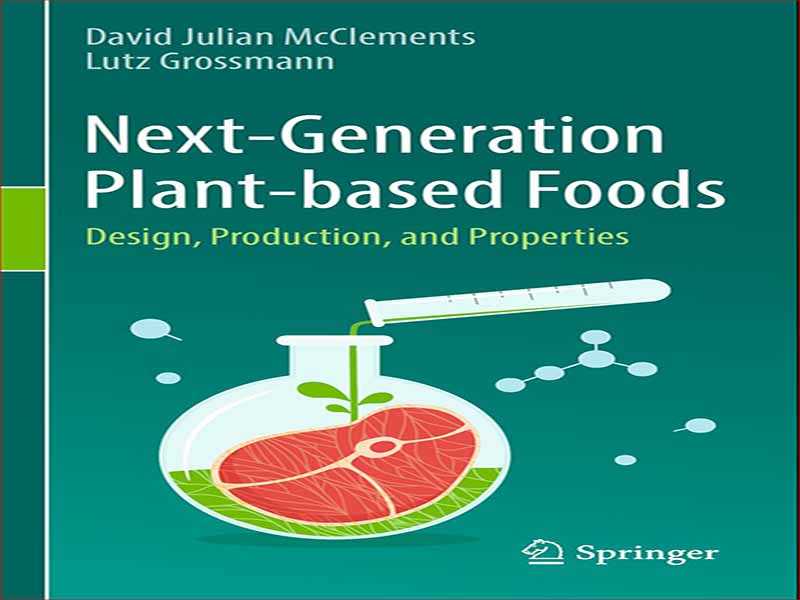- عنوان: Next Generation Plant-based Foods
- نویسنده: David-Julian-McClements,-Lutz-Grossmann
- حوزه: مهندسی تغذیه
- سال انتشار: 2022
- تعداد صفحه: 582
- زبان اصلی انگلیسی
- نوع فایل: pdf
- حجم فایل: 15.3 مگابایت
علاقه بسیاری از مصرف کنندگان به سمت یک رژیم غذایی گیاهی تر افزایش یافته است. تعداد فزایندهای از مصرفکنندگان رژیمهای وگان (بدون محصولات حیوانی)، گیاهخواری (بدون گوشت، اما هنوز مقداری لبنیات و تخممرغ) یا پسکتاریا (بدون گوشت، اما مقداری ماهی) را اتخاذ میکنند. با این حال، معمولاً مصرفکنندگان یک رژیم غذایی انعطافپذیر را اتخاذ میکنند که در آن هنوز گوشت میخورند اما سعی میکنند کل مقدار مصرفی خود را کاهش دهند. در واقع، یک نظرسنجی گزارش شده توسط انجمن غذاهای گیاهی در ایالات متحده نشان داد که تعداد افرادی که همه چیزخوار، انعطاف پذیر، گیاهخوار یا گیاهخوار هستند به ترتیب 65، 29، 4 و 2 درصد است. www. plantbasedfoods.org). مردم دلایل مختلفی را برای حذف یا کاهش غذاهای حیوانی در رژیم غذایی خود بیان می کنند که مهمترین آنها سلامت، پایداری و رفاه حیوانات است (فاکس و وارد، 2008؛ فرسان و همکاران، 2020؛ استول-کلیمان و اشمیت، 2017). از آنجایی که طرفداران انعطاف پذیری در حال حاضر بیشترین درصد از مصرف کنندگان علاقه مند به استفاده از غذاهای گیاهی را تشکیل می دهند و بزرگترین بازار بالقوه استفاده نشده هنوز همه چیزخواران هستند، تمرکز بر تولید غذاهای گیاهی که به طور دقیق ظاهر، احساس و طعم غذا را شبیه سازی می کنند، شده است. آنهایی که مبتنی بر حیوانات هستند سپس این محصولات را می توان به راحتی در رژیم غذایی افراد بدون ایجاد تغییر بزرگ در سبک زندگی گنجاند. غذاهای حیوانی شامل طیف متنوعی از محصولات مانند گوشت (گوشت گاو، بره، خوک، مرغ، همبرگر، سوسیس، ناگت)، غذاهای دریایی (ماهی، میگو، گوش ماهی)، لبنیات (شیر، خامه، پنیر، ماست)، و محصولات تخم مرغ (تخم مرغ همزده، سس مایونز، فلانس). بسیاری از این غذاهای حیوانی ذاتاً مواد پیچیده ای هستند که ویژگی های فیزیکی و شیمیایی، ویژگی های حسی و پروفایل های تغذیه ای آنها به نوع و سازمان ساختاری اجزای مختلف آنها بستگی دارد. به عنوان مثال، پروتئینهای موجود در غذاهای ماهیچهای در ساختارهای فیبری تو در تو پیچیده سازماندهی میشوند که تأثیر قابل توجهی بر ظاهر، احساس و حس مطلوب این محصولات گوشتی و ماهی دارند.
There has been a surge of interest by many consumers in moving towards a more plant-based diet. An increasing number of consumers are adopting vegan (no animal products), vegetarian (no meat, but still some dairy and eggs), or pescatarian (no meat, but some fish) diets. More commonly, however, consumers are adopting a flexitarian diet where they still eat meat but are trying to reduce the total amount they consume. Indeed, a survey reported by the Plant-based Foods Association in the United States indicated the number of people identifying as an omnivore, a flexitarian, a vegetarian, or a vegan were 65%, 29%, 4% and 2%, respectively (www. plantbasedfoods.org). People give a variety of reasons for excluding or decreasing animal-based foods in their diet, with the main ones being health, sustainability, and animal welfare (Fox & Ward, 2008; Fresan et al., 2020; Stoll-Kleemann & Schmidt, 2017). As flexitarians currently make up the largest percentage of consumers interested in adopting plant-based foods, and the largest potential untapped market is still omnivores, there has been a focus on creating plant-based foods that accurately simulate the look, feel, and taste of animal-based ones. These products can then easily be incorporated into a person’s diet without making any large lifestyle changes. Animal-based foods include a diverse range of products, such as meat (beef, lamb, pork, chicken, burgers, sausages, nuggets), seafood (fish, shrimps, scallops), dairy (milk, cream, cheese, yogurt), and egg (scrambled egg, mayonnaise, flans) products. Many of these animal-based foods are inherently complex materials whose physicochemical properties, sensory attributes, and nutritional profiles depend on the type and structural organization of the different components they contain. For instance, the proteins in muscle foods are organized into complex nested fibrous structures, which have a pronounced impact on the desirable look, feel, and mouthfeel of these meat and fish products.
این کتاب را میتوانید بصورت رایگان از لینک زیر دانلود نمایید.
Download: Next Generation Plant-based Foods




































نظرات کاربران